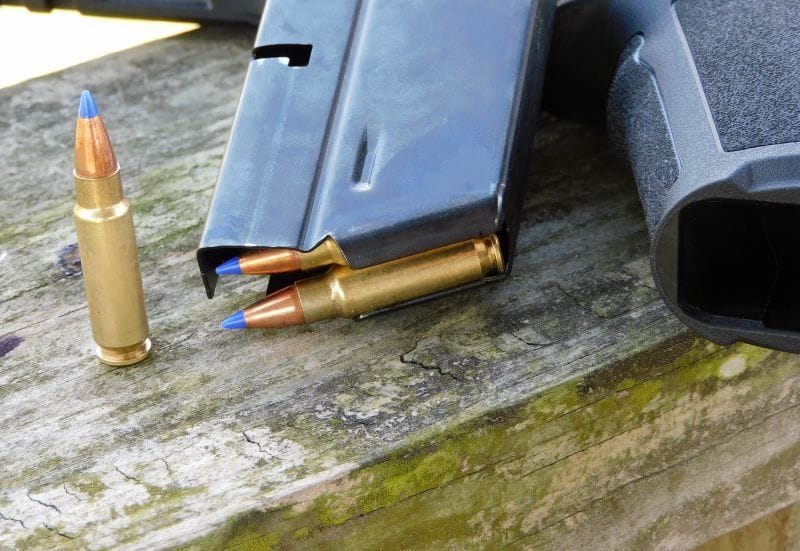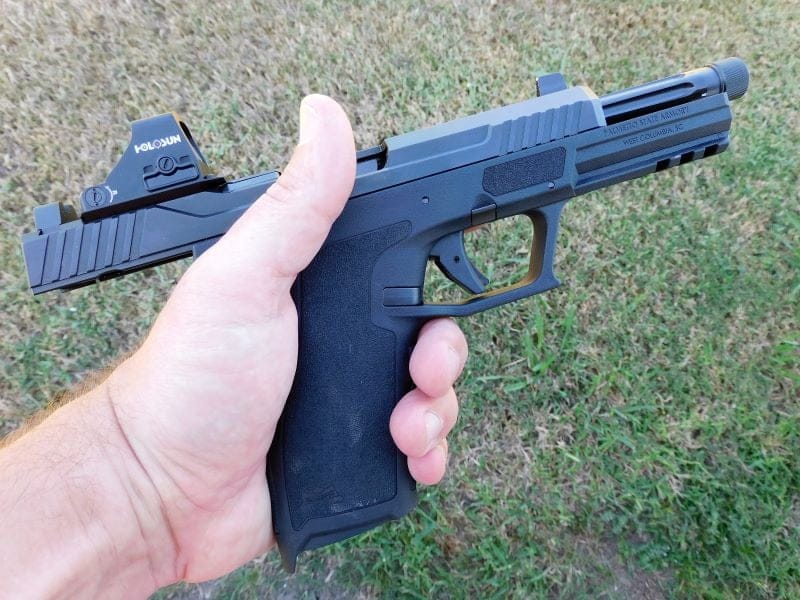The 5.7x28mm FN cartridge has been around since 1990 but only recently appreciated by a larger share of the shooting public. The 5.7 offers similar energy to 9mm Luger while the physically skinnier round boasts less recoil and a higher magazine capacity. For a time, FN and their Five-Seven pistol cornered the handgun and ammunition market. FN’s monopoly melted away over the last ten years as ammo makers like Fiocchi, Federal, and Speer introduced ammunition for the American market. Lately, the pistol market thawed as well.
Ruger broke open the floodgates with their 57 in 2019. In 2023, Smith & Wesson came out with their own 5.7 pistol. Recently, Palmetto State Armory introduced the PSA 5.7 Rock, a pistol as unpretentious as its name and priced to compete. In early 2023, I came into a PSA Rock. With six hundred rounds downrange, here are the thoughts of a thoroughly average shooter.
The PSA 5.7 Rock Features
If we cataloged all the existing 5.7x28mm pistols on the market, there are still a few of them. However, the PSA 5.7 Rock is at the bottom of the list when it comes to price. Does that mean it is the least worthwhile? Not exactly. Until a few years ago, the FN Five-Seven was the only pistol around, and supply was far lower than demand. You were going to pay for it. Ruger and Smith’s pistols undercut FN, and prices have now fallen. PSA took it a step further by marketing a $400-600 5.7 pistol in a market where $1000 isn’t unheard of. $2000 wasn’t farfetched not long ago. Compared to these other brands, PSA is a newcomer. Nevertheless, I was pleasantly surprised by the pistol’s features for the money spent.

Like all other contenders, the PSA Rock is a duty-sized handgun. The stock model has a 4.7-inch barrel and 23-round magazine capacity. My particular model is the RK1 Optics Ready model, which is functionally identical to the base pistol. The RK1 has a longer 5.25 inch 1/2×28 inch threaded barrel, taller steel sights, and a slide cut for an included Holosun 407K red dot optic. Its optics footprint is set up for Shield-style optics except for the small Leupold Delta Point Pro. The pistol comes with RMR and DR adapter plates.
Unlike other 5.7 pistols, the PSA 5.7 Rock is a striker-fired pistol. It has a polymer frame and 416 stainless steel slide with forward and rear cocking serrations. The polymer frame has subtle texturing on the grip, backstrap, thumb rest, and squared-off trigger guard. Its frame also has a section of Pic 1913 rail for mounting a weapon light. The Rock has a reversible magazine release and slide stop exclusively for right-handed shooters.

The PSA Rock comes from the factory with two 23-round magazines. Magazines are double-stack and double-feed with stamped-steel body and polymer base plate. PSA’s magazines are virtually identical to Ruger 57 magazines, except they’re slightly longer with a few extra rounds. Rock magazines will work in the Ruger as well. The Rock ships with a soft-sided carrying case alone or with an included optic, depending on the package.
PSA Rock Disassembly and Function
The PSA Rock is simple to disassemble and uses a Walther-like disassembly technique. The takedown block inside the trigger guard is pulled down as the slide is retracted slightly. From there, the slide can go forward, and the pistol is dry-fired, so the slide comes off the frame. Internally, the Rock has recessed steel rails buried in the frame. The pistol uses a single recoil spring and polymer guide rod. The fluted barrel partially locks into the ejection port opening of the slide, but the pistol itself is not a true locked-breech design.

The PSA 5.7 Rock on the Range
The PSA Rock represented a lot of firsts for me. It was my first time behind a red-dot-equipped pistol. It was also my first time behind a pistol chambered in the unique 5.7×28 cartridge. The Rock was also my first threaded-barreled pistol, although I didn’t shoot with a suppressor.
The RK1 Optics Ready

For the base model, all you have to worry about is the iron sights when you head to the range. My optics-ready model came with a flush plate mounted with screws so you can use the pistol out of the box. I removed that plate and mounted the included Holosun 407KX2 with the DR plate to the pistol. The DR plate is sufficiently low to co-witness the Ameriglo iron sights with the red dot. Unfortunately, the RMR mounts too high to effectively use the iron sights should the optic’s battery go down.
The Rock’s Accuracy
To get a feel for the pistol, I set up some paper targets at ten yards and shot a mix of Federal American Eagle 40-grain TMJ and FN 27-grain lead-free ammunition. The red dot needed to be dialed down a bit, but I was rewarded with good free-standing groups that measured just over one inch. After adjusting my red dot, I produced clusters under four inches out to twenty-five yards with both ammunitions.

I have since ran the Rock with most 5.7x28mm loadings on the market, from light FN SS195LF 27-grain loads to Fiocchi Subsonic 62-grain ammunition. Although there are slight point of impact shifts, I never had a failure to feed or fire from the Rock. This is in spite of it not getting any particular cleaning.
Operating the PSA Rock
The trigger itself is very Glock-like, with an inner safety blade inside the outer trigger shoe. Both must be depressed for the pistol to fire. Like a Glock trigger, the Rock’s take-up is a bit mushy, but the break is definitive. When measured on my Lyman scale, the trigger broke at 4 1/2 pounds. The reset is short and audible, allowing for quick follow-up shots. The trigger press might not impress those accustomed to a competition-grade 1911, but it was a cut above a lot of striker-fired pistols on the market. It is far better than the mushy mess from the FN Five-Seven.

The Rock is a full-sized pistol with plenty of grip to hold onto, but the long 5.7x28mm round makes for a correspondingly long grip. This can be a struggle if you are shooting with smaller hands. The top of the backstrap is sufficiently trimmed for the best possible trigger reach. Although it is a chore to accommodate the long 5.7 cartridge in double-stack magazines, PSA managed to make a grip that fits the hand well without feeling like the edge of a clipboard.
The magazine release was easy to hit without shifting my grip. The slide stop isn’t necessarily friendly to a lefty, but it isn’t a chore to hit with my middle finger. It’s easy to thumb down with your right hand — even on an unloaded magazine. The magazines have tight springs out of the box. It wasn’t overly difficult to punch the first 20 rounds into the factory magazines. This is providing you don’t lose interest after putting in so many rounds. After getting the last three rounds in, I let the magazines sit for a few days before the first range trip. Since then, the magazines have loaded smoothly with little effort.
The Rock’s Recoil
In terms of actual shooting feel, I had trouble placing the 5.7×28. Unloaded, the pistol is light for its size at only 25 ounces. On paper, the 5.7 has similar energy to 9mm Luger, so I thought I would shoot the Rock alongside my favorite 9mm pistol, the Walther PDP Compact. While completely subjective, recoil was about 20% less than 9mm, and I engaged multiple target drills at faster intervals with the Rock. Some of the snappiness of the 9mm is perhaps relative to the sedate recoil impulse of the 5.7. The 5.7 is a longer cartridge with a longer cycling length and time. The more I paid attention to the Rock’s recoil impulse, the longer and softer it felt.
Bottom Line
Just like the 5.7×28 FN cartridge is not going to be everyone’s cup of whiskey, the PSA 5.7 Rock is not going to be the right pistol for everyone. After quite a few range burndowns and a series of GMW ballistic tests evaluating the 5.7 round, I came to understand why the round has so many fans. While it won’t replace 9mm Luger for all applications, it certainly isn’t a glorified .22 rimfire cartridge either. The 5.7 is a serious round that doesn’t beat your hand when you touch it off. Thanks to guns like the PSA Rock, the round is only going to get even more accessible.
I noticed the price disparity of the Rock to its peers early — and with concern. However, the more I shot my Rock, the more I could not find any shortcuts. The PSA 5.7 Rock is indeed a reliable, well-thought-out 5.7 design for the rest of us that performs better than its price tag suggests.

